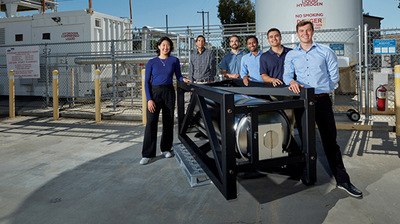Applying science and technology to improve national energy security, protect the environment, and understand and mitigate climate change
Laboratory researchers apply leading-edge capabilities to develop efficient and sustainable energy technologies and to investigate the processes behind climate change.
Groundbreaking Exascale Simulations
An LLNL-led team, including researchers from seven other DOE laboratories, received the inaugural Gordon Bell Prize for Climate Modelling. The team’s winning submission was the efficient and performance-portable implementation of SCREAM (Simple Cloud Resolving E3SM Atmosphere Model)—the first to break the one-simulated-year-per-day barrier for realistic cloud-resolving simulations at less than 5 kilometers of horizontal resolution. What separates SCREAM from other climate models is its ability to perform efficiently across a spectrum of computer architectures—and running faster than any other climate model on Frontier, the exascale machine at Oak Ridge National Laboratory. Another LLNL team reached a milestone in power grid optimization on Frontier. This largest simulation of its kind used 9,000 nodes to determine safe and cost-optimal power performance over 100,000 possible grid failures and weather scenarios in just 20 minutes. Ensuring the nation’s electrical power grid can function with limited disruptions in the event of a national disaster, catastrophic weather, or an attack is a key national security challenge. The goal of the project was to show that exascale computers are capable of exhaustively solving this problem in a manner consistent with current practices of power grid operators.
Assessing Human-Caused Climate Influence
Laboratory scientists and colleagues have demonstrated for the first time that extending climate “fingerprinting” techniques to the mid- to upper stratosphere (25 to 50 kilometers above Earth’s surface) improves the detection of human effects by a factor of five. New analyses also help reconcile differences between satellite data and the warming simulated by climate models, which have outpaced the observations since 1979. A number of factors may contribute to this discrepancy. Using machine learning and large ensembles of climate model simulations, the research team found that internal variations in Earth’s climate have, by chance, reduced real-world tropospheric warming over the satellite era. A spurious discontinuity in prescribed biomass-burning aerosol emissions has also artificially enhanced the simulated result. These two effects largely explain the difference between simulated and observed tropical tropospheric warming.
Materials for Scalable Carbon Capture
In a significant stride toward implementing scalable climate solutions, LLNL scientists uncovered how some carbon capture materials have improved lifetimes compared to others. Researchers demonstrated epoxide-functionalization as a mechanism for extending the operational lifespan of poly(ethylenimine)sorbents, materials that are efficient in capturing carbon dioxide (CO2) from flue-gas point sources and the atmosphere. Simulations showed that introducing new functional groups into sorbents fosters robust hydrogen bonds within the material’s structure and slows undesired oxidation reactions that diminish performance. Enhanced sorbents exhibited exceptional durability over multiple cycles of use. Laboratory scientists and collaborators also investigated whether carbon mineralization of rocks might be another dependable means for long-term storage of carbon. The process occurs naturally when magnesium and calcium-rich rocks, known as ultramafics, are exposed to CO2-rich water. The researchers used the Laboratory’s Center for Accelerator Mass Spectrometry to analyze the radiocarbon content of recently exposed ultramafic rock surfaces and found that carbon mineralization was indeed sequestering atmospheric CO2. This work supports efforts to scale up the carbon mineralization process for reliably drawing down atmospheric CO2 levels.
Carbon Capture in Soil
As part of DOE’s new Energy Earthshots Initiative, LLNL scientists received about $17 million to create a center, called Terraforming Soil, for advancing the fundamental understanding of atmospheric CO2 drawdown in soils. More carbon, in both organic and inorganic forms, is stored in soil than found in the atmosphere and land plants combined. Agricultural soils in the United States have lost a vast amount of carbon over the past century through cultivation and erosion. However, active management of agricultural lands with strategies that capture atmospheric CO2 has clear potential to reverse this trend. The new center will build on LLNL scientists’ recent development of a new technique to better understand soil microbial interactions. The new method automates several steps in the stable isotope probing process, allowing investigations of microbial activity of microorganisms under realistic conditions without the need for lab culturing. In this proof-of-concept study, researchers illustrated the “food web” of interactions stimulated by mycorrhizal fungi in soil, which is theorized to be a major route for broad distribution of plant carbon within the soil.
Hydrogen Storage Hits a Milestone
Building upon LLNL’s decades of pioneering research in hydrogen storage, researchers at the Laboratory and Verne, a San Francisco-based start-up, have simulated, tested, and demonstrated a cryo-compressed hydrogen (CcH2) storage system that for the first time is of suitable scale and high enough density to efficiently serve heavy-duty vehicles. Powering heavy-duty vehicles requires very energy-dense storage systems—better than even the most advanced batteries—and CcH2 outperforms other hydrogen storage options. For the last two years, Verne has been testing their storage systems at the Laboratory’s Cryogenic Hydrogen Fueling Facility. Recently the team tested a single tank system, demonstrating storage of more than 29 kilograms of cryo-compressed hydrogen in a system compact enough that it can fit where diesel tanks are typically installed on a Class 8 truck. Within the transportation sector, heavy-duty vehicles that rely on fossil fuels generated 23 percent of U.S. greenhouse gases.







